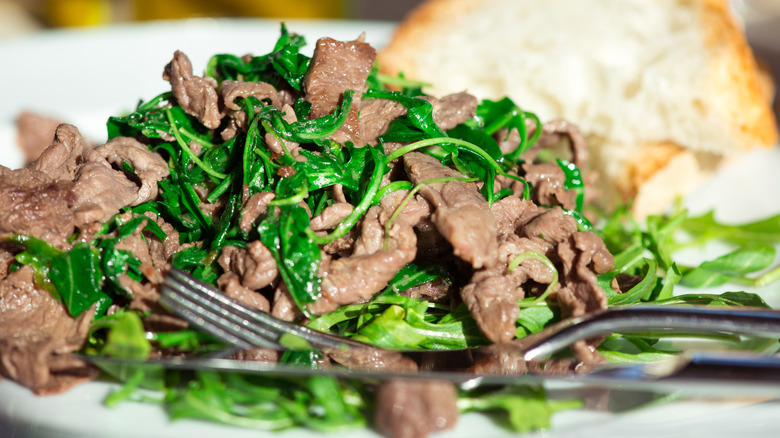Straccetti Is The Elegant Beef Dish You'll Find In Italy
There is an old cliché in the food-writing community that concerns two words: elegance and simplicity. While the phrase has been used rather liberally over the years, it really cannot be avoided when it comes to straccetti. The cliché comes into play, in part, from the Italian-to-English translation. The full title for the dish, straccetti di manzo, sounds wonderfully elegant. Translate that into English and you get, roughly, "little rags of beef." Elegance, meet simplicity.
Straccetti is a classic beef dish from the central Italian region of Lazio, the home of Rome. The meal is a combination of thin slices of beef, hence the rags moniker, that have been quickly sautéed in olive oil. The straccetti are lightly seasoned with a little salt, and sometimes garlic. The dish is finished by tossing the beef in a bed of spicy arugula and topped with parmesan cheese. It is an incredibly simple preparation, but the result cannot help but live up to the cliché.
The secret to good straccetti is not to overdo things. It's all about the integrity of the ingredients, which is where elegance comes into play. The beef, cheese, and arugula all play a part in the cohesive whole. Each is able to retain its great individual flavor. And even though the name might sound very old-fashioned, the dish didn't actually come into any kind of popularity until relatively recently.
An icon of central Italy
The interesting thing about straccetti is that it is simultaneously contemporary and old. It is not exactly known when the first straccetti was made, but it became a staple of small, rustic Lazio eateries known as fiaschetterie. These little trattoria-type restaurants once dotted countryside roads and city streets. The idea was to serve informal, affordable food, and enjoy the local wine. Though this is conjecture, it can be reasoned that, as meat was expensive throughout much of Italy's history, slicing up the beef into thin rags was likely an economical way of making an ingredient stretch. It's little things like this that often unintentionally create culinary icons.
The reason straccetti can also be considered something of a contemporary dish is that it did not hit its stride internationally until the 1980s. This was around the same time that arugula was starting to become a popular ingredient in certain food circles. Naturally, as arugula plays an integral part in straccetti, one became popular along with the other.
Today, it is easy to find the ingredients you need to make straccetti at home. Most Italian supermarkets already stock thinly sliced beef or veal, so a good amount of the prep work is already done for you. Plus, it's easy to find in restaurants if you happen to live in or are visiting the Lazio region.
How straccetti is made
If you don't have access to the meat section of an Italian grocery store, you're going to have to do your own beef slicing at home. Aim for cuts like rump roasts, London broil, ribeye, or skirt steak. Next, you'll need some baby arugula and parmesan cheese. You can also add tomatoes, balsamic vinegar, and even mushrooms if you feel like experimenting. However, the most traditional route is straight beef, greens, and cheese.
You have to slice the beef very thinly in order for this dish to work its magic. Paper thin is what you're going for. Use a meat mallet if you can't cut it that thinly. Remember, they're called little rags for a reason. You can soak the beef in the olive oil briefly before it hits the pan. As soon as the pieces start to brown, the beef slices are tossed in order to get evenly coated with olive oil and meat juice. Next, the arugula is added and tossed until the leaves just begin to wilt. Unlike a super-slow stracotto pot roast, straccetti is flash-cooking at its finest.
Once everything is plated, the parmesan is generously sprinkled over the top and allowed to melt slightly. Then you can tuck in. You should get the peppery tang of the arugula, the saltiness of the cheese, and the rich meatiness from the beef. All told, you'll be making this more than once if your taste buds have anything to say about it.


